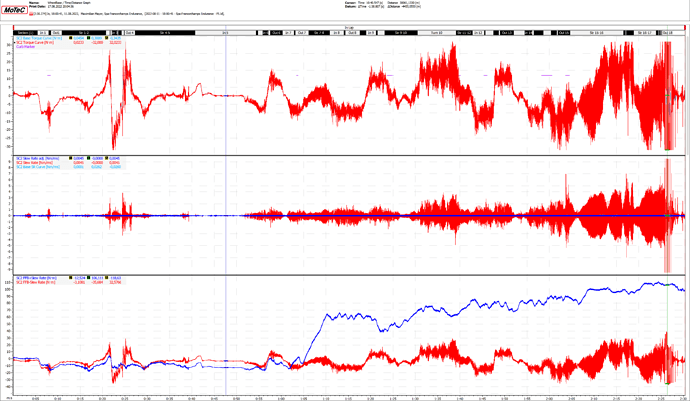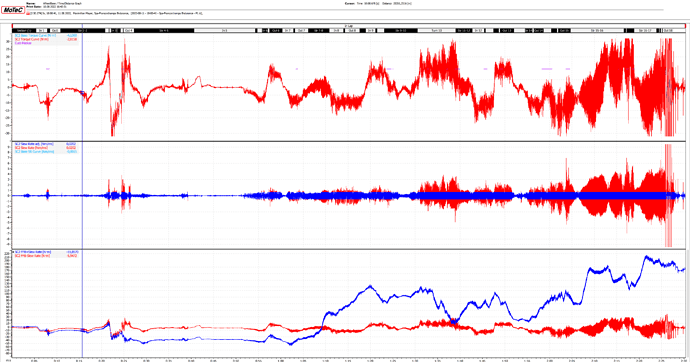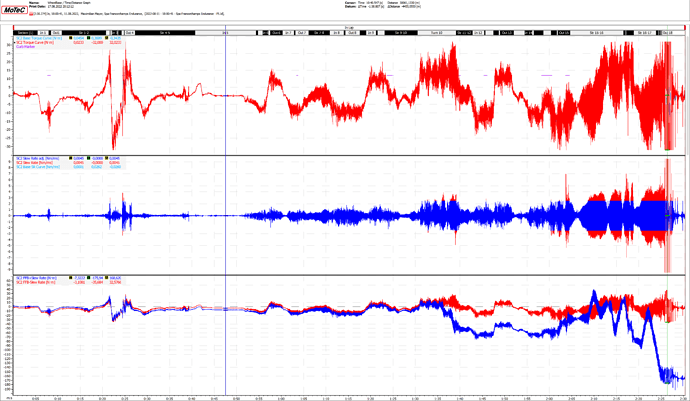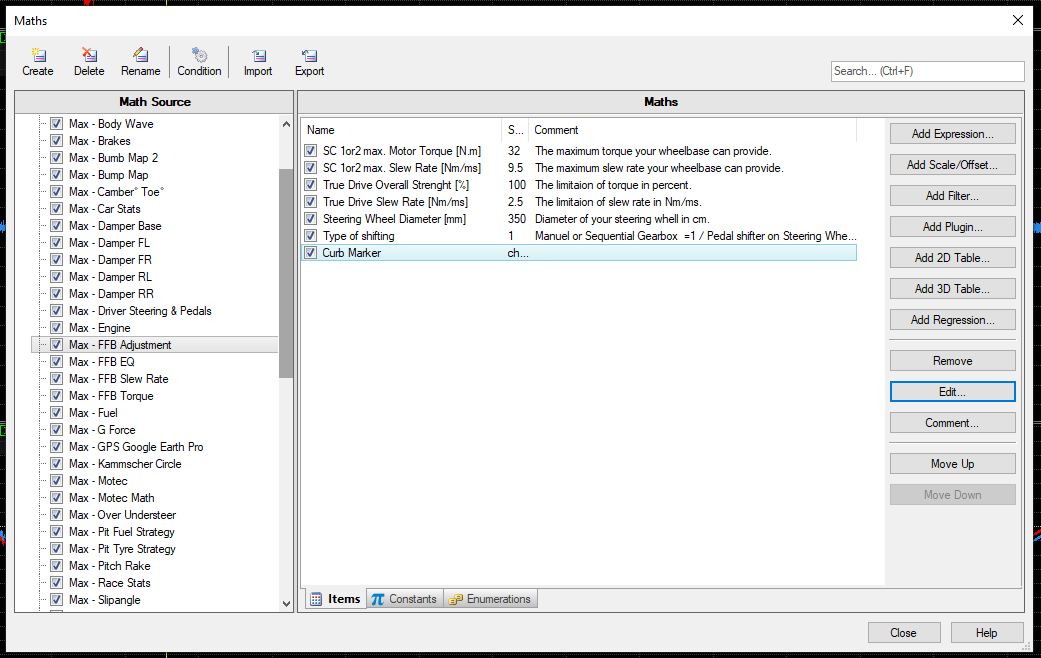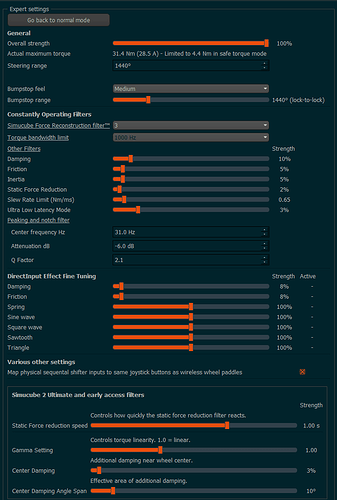Yeah, Porsche GT3 RS
Ah thanks Brion! I didn’t realise it was such a simple Formula.
Do you by chance have a formula for working out the best slew rate for an Ultimate wheel?
Or is 3.25 a good setting for all wheels?
What’s slew rate and what does it do?
I believe, but don’t quote me, it slows down the reaction time of the wheel when lots of FFB is being sent to the wheel.
So if you go over a kerb, it doesn’t forcefully throw the wheel from side to side in a split second. It slows down the reaction time to make it smoother.
I think.
Yea the specific output is just a ratio of the actual output from the wheel to the output that the telemetry gives.
With Slew… No, that is something you sort of have to feel out. The thing to look for is if the wheel feels as if it is causing you to saw at it…
Most of the time that I notice this is on a return to center moment after a minor oversteer. Normally in a real car you should be able to control a slight oversteer with minor adjustments to the wheel. However a wheel that is too fast will snap back toward center at a rate that you as the driver cannot keep up with… This causes you to saw at the wheel a bit to regain control and find center where in reality you should be able to use just throttle control and slight inputs to bring the car back in line…
Some people like this quick snap back as it makes them feel the car is being reactive (and some cars depending on settings in the suspension or track surface can be(i.e older style nascar cars on an oval where they are setup biased and you se the car get loose and they ca hold onto it JUST until the put too much correction and it shoots to the wall) Problem is with an overly active return this shoot to the wall no longer has to do with the car but the return uncontrolled overcorrection of the wheel.
So it is something that does have to be played with and becasue I don’t have an ultimate I cannot really say what would be a good setting… However I would say that you will probably be around the same number as the Slew is a torque application over time.
F1 cars are, compared to F3, much more easier to steer when we talk about the force needed. Some of actual F1 drivers said that steering in F3 was very demanding, due to the lack of power steering.
It’s the acceleration of the motor. Lowering slew rate makes the steering more rubbery/realistic.
Turn it down to 1 and hit some curbs. You’ll notice what it does then.
The difference between 3.25 and unlimited is not so obvious, but once you go below 2 you’ll feel the difference.
I drive with slew rate 2.2. It’s a good compromise between detailed info, but a realistic/less robotic feeling.
We have TBW, Slew Rate limit, all these params limit physical potential of the servo.
You’ve paid extra for more reactive motor but run it on a fewer cylinders.
More “rubber” and wheel weight can be accomplished via Damper/Friction/Inertia, also Recon if you want smoother signal. It’s a more conventional, traditional way without resorting to “exotic” params very few understand and killing your servo potential in the process.
Overcomplicating things seems to be a trend among simracers.
no, lower value is less reactive. But outright 0 means that the filter is turned off.
Really, I thought it was changed to be the actual limit applied on the top of existing rate. Seems like it’s still absolute value of a Slew Rate. Thanks for correcting, may be a good idea make it look more meaningful in UI.
Yeah, we actually discussed it when implementing the slider for the effect. Either way it would be confusing in some way - if the slider was “inverted” compared to how it is now, the value on the slider would decrease when moving it to the right. Then again, we prefer technical explanation of an effect instead of just arbitary number. However in this case the technicality is what makes it confusing.
Same goes for the torque bandwidth limit filter if that was implemented as a slider…
Slew Rate is the best “Effect” of the Simucube2! It is so POWERFULL. I use it simelar like a “Bass - Compressor” and you should do that too. You tune your FFB-Signal to its finest! Keep an eye Flat-Spots at the last half lap. Also the Crash at the End.
Slew Rate in dark blue…
0.1Nm/Ms
0.65Nm/Ms
2.5Nm/Ms
9.5Nm/Ms
If I read it right (probably not), it shows by how much at lower slew rate reaction of the motor deviates from, lags behind signal.
Cool graphs, btw, wish TD had some monitoring tool.
How do you capture all this data, including slew rate?
So all four screenshots show the same 3 graphs with different “Slew Rate’s” (0.1 /0.65 /2.5 & 9.5Nm/Ms).
On the first graph:
“SC2 Base Torque Curve[Nm]” shows the basic FFB-Torque…like curves for example and a bit of oversteering if it doesn’t require too much slew rate.
“SC2 Torque Curve[Nm]” shows simply the FFB signal output by (in this case) Rfactor2. So the “car multiplier”(aka PreAmp) has an influence on the curve, but also the settings in the .json files.
“Curb Marker” tells me if I’m currently driving on curbs. The reason is that I get a hind where the frequencies come from that bother me. In “La Source” you can see it quite well. (Doesn’t look like a big deaL, but it’s super practical =) Especially because the games aren’t 5-star orchestras. Hope no one will be mad at me, but anyone who has ever worked with Cubase or Wavelab knows that the CPU places limits on signal generation and SimRacing is signal generation.
The second graph just shows different slew rates.
“SC2 Slew Rate adj. [Nm/ms]” shows me the slew that I would like to visualize. In other words, I recreated the “True Drive- Slew Rate -Effect” in Motec. As above (0.1/0.65…). I used to call it Adjusted (adj.).
Here you can then adjust everything. Maximum torque & slew rate of your base and of course your true drive settings. It’s interactive so the Sport, Pro and Ultimate can use it.
“SC2 Slew Rate [Nm/ms]” is the slew rate the game wants, but limited by the maximum slew rate of the wheelbase. I always put the slew rates on top of each other… so you can see where the signal is being compressed. Is then the blue curve before the red curve.
“SC2 Base SR Curve[Nm/ms]” shows me the slew rate of the “SC2 Base Torque Curve [Nm]”. Namely, if you give your Simucube2 less slew rate than it needs for cornering and oversteer, you’ve definitely gone too far.
With the third graph I do the calculation back into a torque. So the red slew rate curve, which is only limited by the maximum slew rate of the SimuCube, and the blue slew rate curve, which is changed by our True Drive setting. Unfortunately, this is then distorted (NOT IN THE GAME, ONLY IN MOTEC), but you can tell by the thick curves in the flat spots. So based on the ratios and the peak to peak values. For example, with the 0.65Nm/ms slew rate I reduce the torque of the crash from ~54Nm to ~10Nm… i.e. reduced by 44Nm. So you can let children play with it with a clear conscience. 
Slew rate and static force reduction are extremely helpful imo. Slew rate limitation can make the difference when one has a huge crash at high speed. Static force reduction gives the opportunity to use more torque in general, while certain situations (fe Silverstones high speed combo Copse/Maggotts/Becketts) still can be driven at a full length race without getting too tired. Both don’t filter anything out of the amount of FFB information. Damping is adding latency, something friction does not, although you will loose fidelity/speed at the shaft with it.
Both are problem solver rather than anything else. You can use ULLM to compensate the latency you created with damping and friction.
These diagrams are interesting. To have something similar in TD is totally unnecessary. If one is interested in engineering there is sure (as we can see) plenty of 3d party software.
As a driver you don’t need to interfere with the job of engineers. Even you are good at it: no-one wants you to do such things. Be fast, win the race and let them do what is necessary for you to win.
If some already have a problem to understand what a limitation of a defined maximal value is, then TD sure doesn’t need integrated mechanical physics or telemetry implementation. This would only need a real time connection, which is exactly what brought up resistance
You definitely know more about this than I do but doesn’t lowering the slew rate make the FFB feel sort of “floaty”? That’s the best way I can describe it
Yep I see it that way too. Keep True Drive as slim as possible. It really does offer endless settings to play with.
However, you can also gain additional information with the slew rate and that’s how I use the thing. Compress the curbs and turn the torque up. Imagine totally over the top curbs superimposed on the actual FFB signal. So that you no longer feel the oversteer, but now you do thanks to the lowered slew rate. I’ve had a number of situations there… but I don’t have any right now. Recently cleaned up Motec… needed the space. 
It depends how far. That’s why I built it myself to finally get control over it.
To put it this way. I made a really nice, clear and powerfully defined FFB. I let the thing run at 32Nm and have no problems with it. It’s just great!
Very interesting comparison with Cubase! Compressing signals, how fast a curve of a signal has to rise…
In AC there is a possibility to compress lower/finer FFB signals. The result is a very detailed FFB also at low torque and while driving relatively slow. My favourite cars are open wheelers (RSS and GP). They use power steering. New cars like the the RSS 2022S or the Grand Prix 2022 coming with special physics packages. You can turn steer assist into range compression and this is very clear to see on a FFB graph. If you compare both of them, the one with range compression is much more detailed, and the feeling while driving is showing the same result.
Slew rate limitation is something I was familiar with very soon. I drive rally, and the handbrake input was just to much in too short time. The perfect solution: slew rate limitation. That is also the case when you drive with almost 200km/h through Finlands woods and you run out of talent… and this within max 10 meters: it took a blink of an eye, from 200 to be mash on a huge tree. Again, slew rate limitation is your best friend then!

